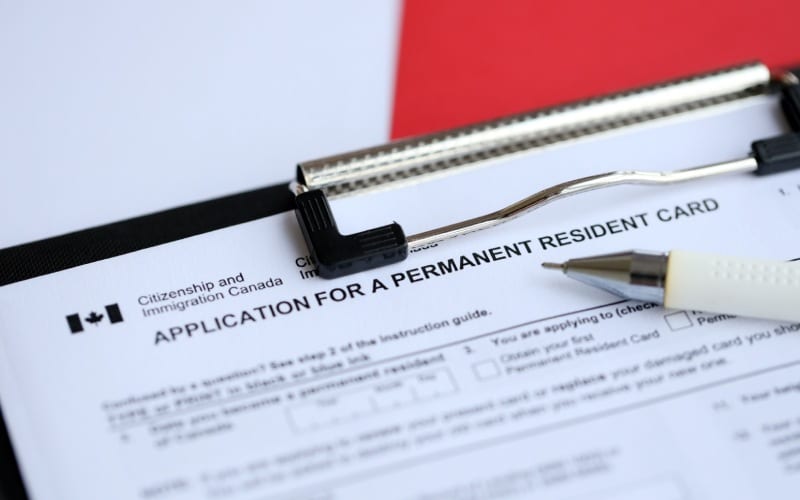In Canada, there are various travel documents that allow those living in Canada to travel abroad and return. Just as a Canadian citizen needs a passport to leave the country and return, Permanent Residency (PR) Travel Documents and Refugee Travel Documents allow certain individuals in Canada to travel.
Travel Document for Canadian Permanent Residency (PR)
Canadian permanent residents are not allowed to have a Canadian passport until and unless they become citizens. To re-enter Canada, permanent residents need a valid PR card, or a Permanent Resident Travel Document (PRTD), along with their passport from their country of citizenship.
Permanent residents (PR) of Canada are required to carry and present either their valid Permanent Resident Card (PR card) or Permanent Resident Travel Document (PRTD) when travelling to and entering Canada.
A Permanent Resident Card is official documentation proving you are a Canadian permanent resident, and is necessary when you are re-entering Canada by airplane, boat, train, or bus. Most Permanent Resident Cards expire after five years, although some expire after one; it’s critical to ensure they are valid past your expected date of return.
If you have been given permanent residency status, but do not have your Permanent Resident Card, such as if it has been lost or stolen, and you are outside of Canada, the Permanent Resident Travel Document (PRTD) is a temporary alternative. It proves you are a permanent resident and are eligible for entry into Canada, even though you do not have a PR card. You will need to apply to renew or replace your PR card when you return to Canada.
Eligibility Criteria
To apply for a Permanent Resident Card, you must have permanent resident status in Canada, be physically present in the country, not hold Canadian citizenship, not be under a removal order, and have no convictions related to misusing a Permanent Resident Card. If you become a Canadian citizen, you will no longer need a Permanent Resident Card.
PRTD Application
To apply for a PRTD, you must submit an application form, along with supporting documents and a fee, to Immigration, Refugees and Citizenship Canada (IRCC). To be eligible for a Permanent Resident Travel Document (PRTD), you must have permanent residency status, be outside of Canada, and not have a valid Permanent Resident Card. You must not intend to voluntarily give up your permanent resident status, and not have lost your permanent resident status. You will need to confirm your status and show that you meet the residency obligations of a permanent resident.
The processing time varies, typically ranging from a few weeks to several months, depending on individual circumstances and external factors.

Refugee Travel Document
Note that before 2015, the Refugee Travel Document was formerly known as the Protected Person Travel Document, and may occasionally be still referred to as that.
An individual who has been granted protected person status in Canada can travel, with some restrictions, with a Refugee Travel Document. It facilitates international travel for those who cannot obtain a national passport. This document is issued to protected persons in Canada, including Convention refugees and persons in need of protection.
You must have been granted protected person status in Canada under the Immigration and Refugee Protection Act (IRPA), and prove that you are unable to obtain a passport from your country of citizenship because of persecution, statelessness, or another compelling reason.
You cannot use your Refugee Travel Document to travel to your country of citizenship.
Application
You must submit an application form, with supporting documentation, to the IRCC and pay a fee. You need to apply from within Canada. Processing times vary; they may be expedited in urgent cases, such as humanitarian emergencies or family reunification.
Comparison of PRTDs and Refugee Travel Documents
Both the Permanent Resident Travel Document (PRTD) and the Refugee Travel Document are issued by the Canadian government to individuals who are not Canadian citizens but have obtained legal status in Canada. These documents act as travel permits, allowing their holders to leave Canada and return without needing to obtain a visa.
Although both the PRTD and the Refugee Travel Document facilitate travel and re-entry for individuals recognized as residents of Canada, they differ in significant ways.
The PR Travel Document is limited to Canadian permanent residents who do not have a permanent PR card, whereas the Refugee Travel Document is specifically for protected persons, including refugees and asylum seekers.
Travelling with a PRTD, you still need your passport from your country of citizenship, whereas the Refugee Travel Document may be granted to individuals who cannot obtain a passport due to persecution, statelessness, or other compelling reasons. It’s important to note, however, that if a permanent resident can’t obtain a passport from their country of origin or a travel document from another source, or is stateless but not a protected person, a certificate of identity can be obtained. The application process is similar to the Refugee Travel Document process.

While both documents involve submitting an application form, supporting documents, and a fee, the process for obtaining a Refugee Travel Document is more complex, because of the intricate legal status of refugees, background checks, proof of refugee status, and other factors.
The processing time for both documents varies but may be expedited in urgent cases. However, individuals applying for a Refugee Travel Document may face additional challenges or delays due to the additional complexities.
If you are a permanent resident or protected person, and have questions about your ability to travel outside of Canada, or need assistance applying for the right documentation, Oro Immigration’s compassionate team of experts can help.


